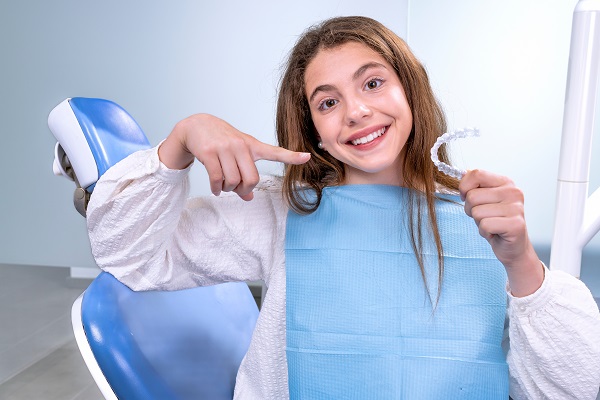Invisalign for Teens: How Long Before Seeing Results?

Whether you choose Invisalign® for teens or another method for straightening your child's teeth, the change occurs gradually. Understandably, your teen may be impatient and want to know when results start being visible. One of the benefits of this method of tooth straightening is that you and your child can get a preview of how the treatment will progress with a time-lapse presentation of 3D models that shows exactly which changes will happen in what order. This should give your teen an idea of what to expect and when.
How does Invisalign® for teens work, and how does that affect the time that your teen starts seeing results?
Rather than putting pressure on all of your teen's teeth at once, Invisalign® is designed to work on only a few teeth at a time. Teeth that are already properly aligned are left alone, while the appliances work on those that are crooked to move them into a better position. This targeted approach reduces the overall treatment time required to straighten teeth, but it can take longer to start seeing results than it would if all of your child's teeth were moving at the same time. Occasionally, Invisalign® patients start seeing results after two weeks time. However, most patients do not see results for up to three months.
Invisalign® is an individualized treatment. Each patient has a custom treatment plan tailored to their own needs. Therefore, it is difficult to predict when each patient will start seeing results because it depends on so many different factors:
- Diet
- Genetics
- Gum conditions
- Jaw shape
- Case complexity
- Patient compliance
What can your child do to minimize treatment time and start seeing results more quickly?
Your child's behavior determines not only how soon results become obvious but also whether the treatment will be completed on time.
Take care of the aligners
To be a candidate for Invisalign®, children must be responsible enough to care for their own aligners. If a set is lost or damaged, your teen may have to go back to the previous set to avoid regression until your provider can make replacements.
Change aligners on time
Finding time for appointments can be tricky between your child's homework schedule and extracurricular activities. However, teens need to make each appointment to change their aligners on schedule to avoid delays in overall treatment time. Keeping to the schedule also helps your teen to be able to see results more quickly.
Wear aligners the recommended number of hours per day
Your teen will receive instructions about how many hours the aligners must be worn per day. Usually, it is between 20 to 22 hours, meaning that your child must wear the aligners all night and during most of the day. If teens participate in sports, they may remove their aligners during practices and games to make room for the mouthguard that protects their teeth from injury. Otherwise, the only activities for which your child should remove the aligners are eating and performing oral hygiene.
Conclusion
Invisalign® for teens should start showing visible results well before treatment is over. However, it may be a matter of months rather than weeks.
Request an appointment here: https://universalcity.ucsmilesortho.com or call UC Smiles Orthodontics at (210) 593-7623 for an appointment in our Universal City office.
Check out what others are saying about our dental services on Yelp: Invisalign for Teens in Universal City, TX.
Related Posts
Adult orthodontics offers practical and streamlined solutions to address alignment concerns while working with busy schedules. Whether the goal is correcting crowding, spacing, or bite imbalances, modern techniques help transform complex plans into manageable phases. With streamlined and personalized approaches, most adults find that orthodontic treatment progresses with greater precision and predictability than expected.Each orthodontic…
Wondering whether wearing retainers is really necessary? Read on to learn more. You know braces and aligners can help you get those straight teeth you desire, but retainers are the next step. These little devices will keep your teeth aligned and your smile beautiful for years.Retainers are custom orthodontic devices that help keep the teeth…
Early orthodontic treatment is more common than most parents realize. While it does sound rather intimidating, parents can rest assured that it is actually quite beneficial for many children. When early orthodontic treatment is done, children are far less likely to experience severe problems later on in life. For example, bad habits are kicked and…
Invisalign is a popular orthodontic treatment that helps align teeth discreetly and comfortably. After completing treatment with Invisalign, it is essential to maintain results to ensure a long-lasting, healthy smile. Proper post-treatment care supports the alignment achieved and prevents shifting that may compromise function or aesthetics.The most critical step in maintaining Invisalign results is the…
